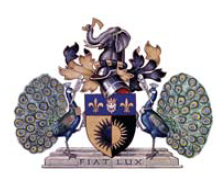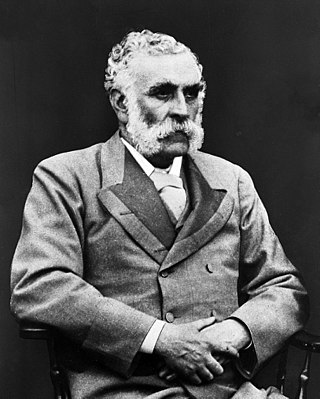
Ophthalmology is a surgical subspecialty within medicine that deals with the diagnosis and treatment of eye disorders. A former term is oculism.

Moorfields Eye Hospital is a specialist National Health Service (NHS) eye hospital in Finsbury in the London Borough of Islington in London, England run by Moorfields Eye Hospital NHS Foundation Trust. Together with the UCL Institute of Ophthalmology, which is adjacent to the hospital, it is the oldest and largest centre for ophthalmic treatment, teaching and research in Europe.
The American Academy of Ophthalmology (Academy) is a professional medical association of ophthalmologists. It is headquartered in San Francisco, California. Its membership of 32,000 medical doctors includes more than 90 percent of practicing ophthalmologists in the United States as well as over 7,000 members abroad.
Hamid Ahmadieh is an Iranian ophthalmologist, medical scientist, and pioneer specializing on the retina of the eye. He is also the founder of Iranian Vitreoretina Society.

Douglas Moray Cooper Lamb Argyll Robertson FRSE, FRCSEd LLD was a Scottish ophthalmologist and surgeon. He introduced physostigmine into ophthalmic practice and the Argyll Robertson pupil is named after him. He was president of the Royal College of Surgeons of Edinburgh.

Professor Dame Ida Caroline Mann, Mrs Gye, DBE, FRCS was "a distinguished ophthalmologist ... equally well known for her pioneering research work on embryology and development of the eye, and on the influences of genetic and social factors on the incidence and severity of eye disease throughout the world". Only six other women were Fellows at this time.
The Egmore Eye Hospital, officially the Regional Institute of Ophthalmology and Government Ophthalmic Hospital, is a public eye hospital in Chennai, India. Considered the oldest eye hospital in Asia, the institute was established in 1819 and is the second oldest hospital of its kind, next only to the Moorfields Eye Hospital in the United Kingdom.
Zeynel A. Karcioglu is a medical and surgical practitioner, researcher and medical educator. He is a diplomate of the American Board of Ophthalmology, specializing in Ophthalmic Oncology and Pathology particularly in areas of retinoblastoma, external eye tumors, and primary and metastatic orbital neoplasms. Karcioglu is also residency and fellowship trained in Anatomic Pathology and Neuropathology and certified by the American Board of Pathology.

Sir George Andreas Berry LLD, FRSE, FRCSEd was a Scottish ophthalmic surgeon who acquired a reputation as a leading authority on ophthalmology, not only in the United Kingdom but also in the United States and continental Europe. His standing in the profession was largely the result of his textbooks of ophthalmology which were widely used in his home country and abroad. His working career was spent at the Royal Infirmary of Edinburgh and when he retired from clinical practice in 1905 he became involved in medical and national politics. He was surgeon-oculist in Scotland to King George V and then to King Edward VII and was president of the Royal College of Surgeons of Edinburgh from 1910 to 1912. He was knighted in 1916. At the 1922 general election he was elected as Member of Parliament for the Combined Scottish Universities, sitting as a Scottish Unionist. He held the seat until he stood down at the 1931 general election.
Geoffrey Rose BSc MBBS MS DSc MRCP FRCS FRCOphth is an English ophthalmologist and Past-President of both the British OculoPlastic Surgery Society (BOPSS) and the European Society of Ophthalmic Plastic and Reconstructive Surgeons (ESOPRS).

Lieutenant Colonel Sir Herbert Lightfoot Eason CB, CMG, MD, MS, FRCS. ) was an ophthalmic surgeon who served in the Great War as a Lieutenant Colonel and Consultant Surgeon to the Forces in Egypt and at Gallipoli. He was appointed Superintendent at Guy's Hospital, London, in 1920, Vice Chancellor from 1935 to 1937 of the University of London. President of the General Medical Council from 1939 and was Knighted in 1943 for his services to medicine.
The Filatov Institute is a research institute and a large ophthalmology (eye) hospital in Odesa, Ukraine. It was founded by Vladimir Filatov, an academic ophthalmologist. Its mission is the study of eye diseases and injuries, the training of ophthalmologists and the provision of eye care in Ukraine. The institute has 700 staff including 27 professors.
Noshir Minoo Shroff is an Indian ophthalmologist, notable for intraocular lens implantation surgery in India and a medical director of the Shroff Eye Centre. The Government of India honoured him in 2010, with the Padma Bhushan, the third highest civilian award, for his services in the field of medicine.

John Marshall MBE, FMedSci, PhD, DSc, FRCPath, FRSB, FRCOphth(Hon), FRCOptom (Hon), FARVO is a British medical scientist and inventor. Currently he is the Frost Professor of Ophthalmology at the Institute of Ophthalmology UCL and Emeritus Professor King's College London. He is a pioneer of laser eye surgery.
Alan Charles Bird is an English ophthalmologist, famous for his work on degenerative and hereditary diseases of the retina.
Sir John Herbert Parsons CBE FRS FRCS was a British ophthalmologist and ophthalmic surgeon.

Robert E. MacLaren FMedSci FRCOphth FRCS FACS VR is a British ophthalmologist who has led pioneering work in the treatment of blindness caused by diseases of the retina. He is Professor of Ophthalmology at the University of Oxford and Honorary Professor of Ophthalmology at the UCL Institute of Ophthalmology. He is a Consultant Ophthalmologist at the Oxford Eye Hospital. He is also an Honorary Consultant Vitreo-retinal Surgeon at the Moorfields Eye Hospital. MacLaren is an NIHR Senior Investigator, or lead researcher, for the speciality of Ophthalmology. In addition, he is a member of the research committee of Euretina: the European Society of Retina specialists, Fellow of Merton College, in Oxford and a Fellow of the Higher Education Academy.

Henry (Harry) Moss Traquair, FRSE, PRCSE was a Scottish ophthalmic surgeon who made important contributions to the science of perimetry and the use of visual field testing in the diagnosis of disease. He was President of the Royal College of Surgeons of Edinburgh in 1939/40 and President of the Ophthalmological Society of the United Kingdom.

George Ian Scott CBE, FRSE, FRCSEd was a 20th-century Scottish ophthalmic surgeon who in 1954, became the first holder of the Forbes Chair of Ophthalmology at the University of Edinburgh. He specialised in neuro-ophthalmology, studies of the visual fields and diabetic retinopathy. He was President of the Royal College of Surgeons of Edinburgh from 1964 to 1967, Surgeon-Oculist to the Queen in Scotland from 1965 and president of the Ophthalmological Society of the United Kingdom from 1970 to 1972.
Lieutenant-Colonel Herbert Herbert, FRCS was a British ophthalmologist and officer in the Indian Medical Service (IMS), known for his work on trachoma, cataract and glaucoma. Later, he was vice-president of the Ophthalmological Society of the UK.









